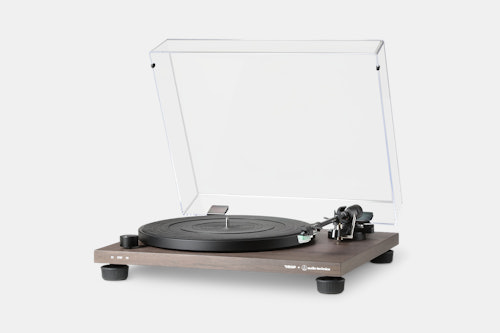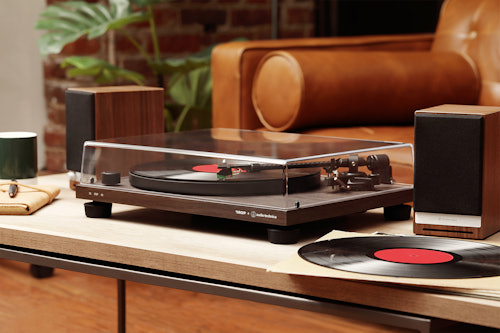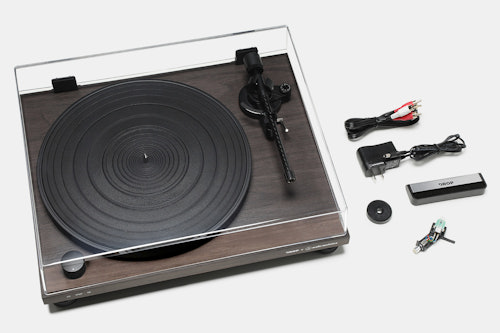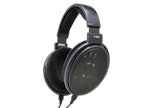Click to view our Accessibility Statement or contact us with accessibility-related questions$399$39998% would recommend to a friend 






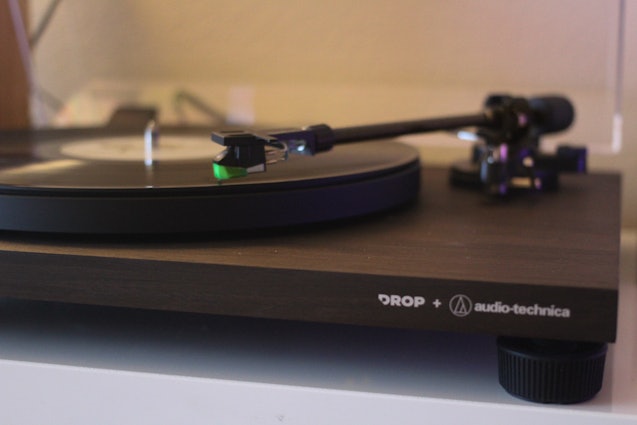
Overview The Drop + Audio Technica Carbon VTA ( referred to as the Drop AT Carbon from here on out) is a strong entry in Drop's fairly impressive custom audio department, providing some unique and higher end features at an entry level price. Included in the box:
The Testing Now, before I go any further I'd also like to point out that this is an entry level turntable, but a good one at that. I mainly compared this to my Pro-Ject Debut Carbon Esprit as it has a closer resemblance of features and price than any of my other turntables (Clearaudio Concept, SOL, Technics SL-1200). The Rega RP-1 and U-Turn Audio Plus are also fairly good tables to compare to the Drop AT Carbon.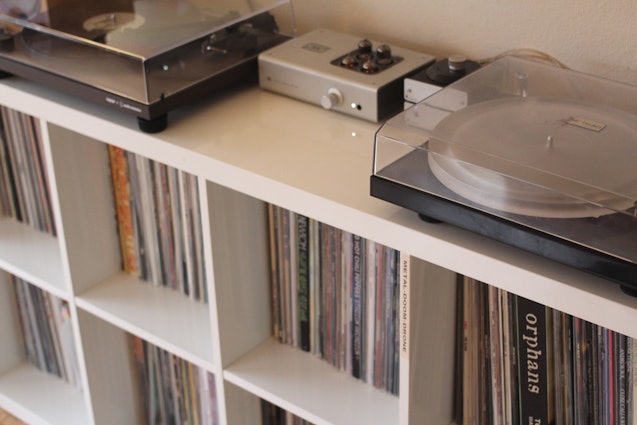
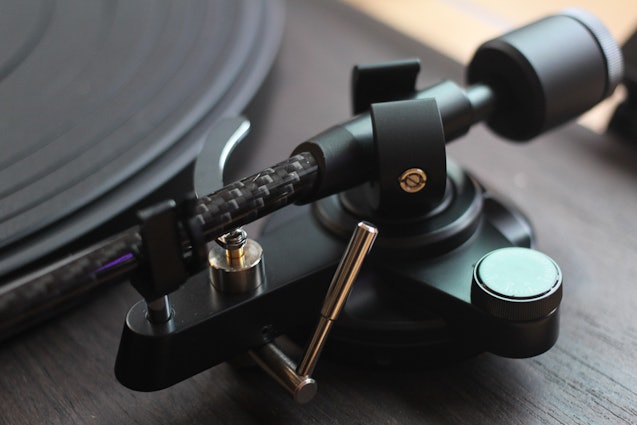
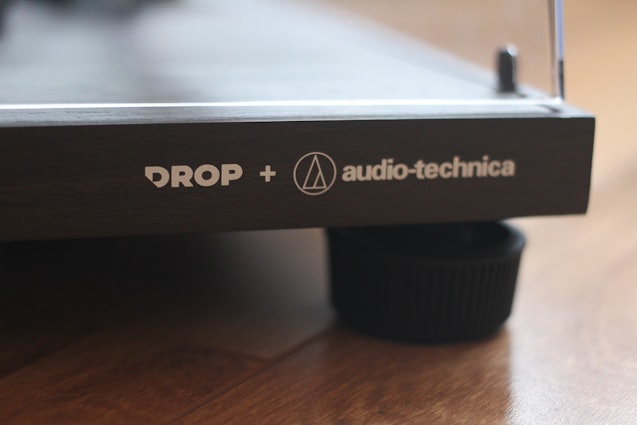
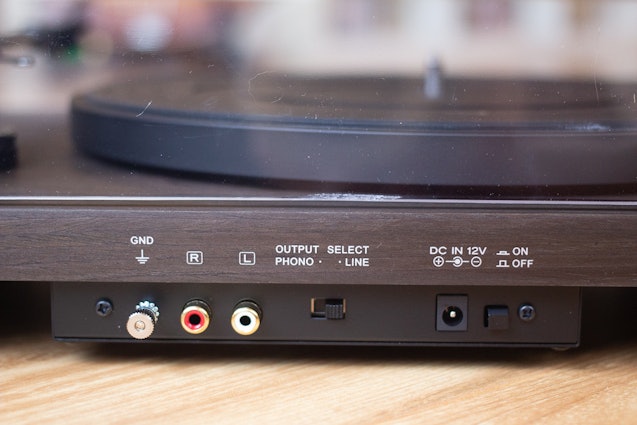

The Verdict Although the Drop AT Carbon isn't the cheapest option out there, I'm glad they didn't set out to make the most budget turntable possible in this collaboration. Instead of trying to shave off every penny they could (as they do in some collaborations), they seemed to manage price and features in a way that resulted in a rather unique offering in this price range. So while there may be some people looking for a more purist entry into the world of turntables (of which there some dominating options already available in that dept.), there are those that will value the convenience and flexibility the Drop AT Carbon offers along with quality that should get a lot of great use out of this turntable. As someone with a masters in audio engineering and hundreds of hours logged in full analog studios, plenty of time spent cutting masters on a lathe, a former record store owner, and avid record/turntable collector, I approve of this deck. I asked for this back in 2016 even haha....
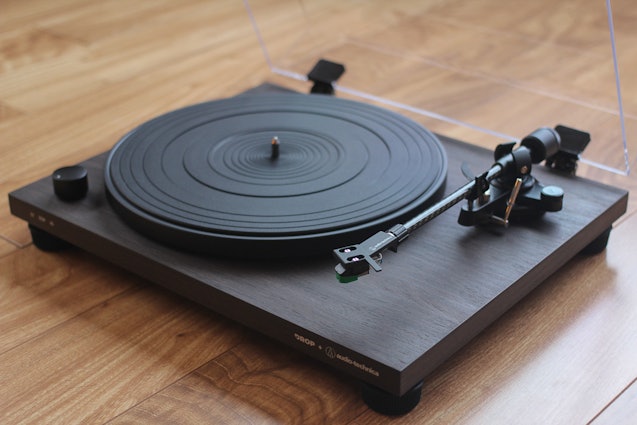



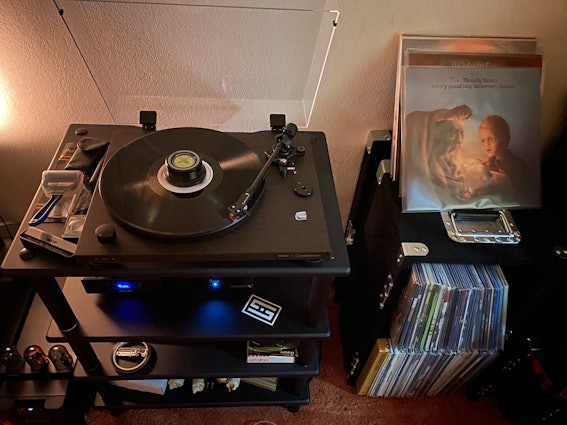
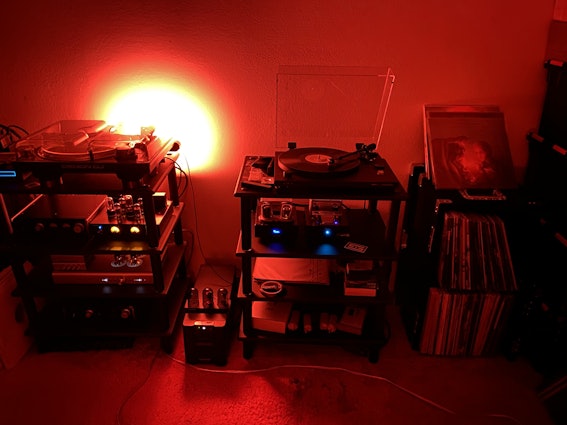









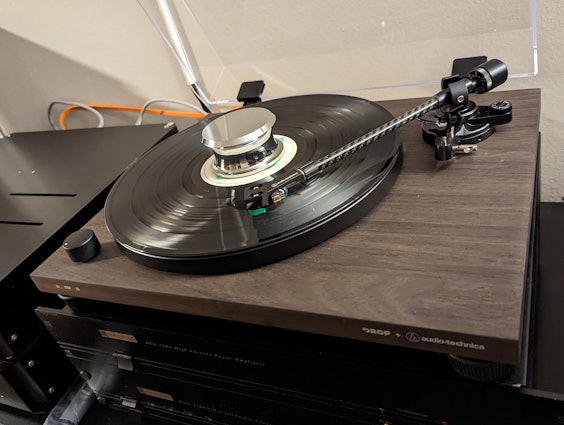

Drop + Audio-Technica Carbon VTA Turntable
$329
Drop + Audio-Technica Carbon VTA Turntable
bookmark_border
$329
·
2.5k Sold
·
Free Returns in USA
●
Members who purchase earn
987
Drop Rewards
Frequently bought together:
Customer Reviews
4.8
(130 reviews)
5star(112)
4star(15)
3star(1)
2star(0)
1star(2)
search
close
Images
keyboard_arrow_downSort by: Top Reviews
keyboard_arrow_downbadasstronaut_solutions
83
Mar 9, 2020
checkVerified Buyer
Shut up and take my money! If you're wanting a new hobby, this is a great entrypoint
I like the product, but I was not going to write a review. Then I thought about it a little more, and I felt like I owed the community. Why? Because all of the other reviews are written by audiophiles with so much knowledge and passion that I felt stupid. This is my first turntable. I would not have been able to point to the "cartridge" before I started learning about my new hobby.
I didn't have 8 custom preamps and every cartridge and stylus combination at hand when my package arrived; I had a handful of vinyls & a decent receiver and speaker system, but no vinyl-specific equipment.
It took me only a few minutes to get the system set up, connected to my receiver, and then I was blown away. Listening to Bowie's "Let's Dance" blew my mind. I've heard most of the tracks off this album, but this was my first listen on vinyl. I won't go into detail about analog and digital signals, and I certainly don't want to weigh into any debates, but I thought that the "sounds better on vinyl" mentality was exaggerated.
I was completely wrong. The sound of vinyl through the Carbon VTA has been a joy to experience. I feel like a whole new world of music and listening has been unlocked, and I can tell that my new hobby is about to become a full-blown addiction.
If you're on the fence about getting into vinyl, or just feel overwhelmed by the technicality of the field, I strongly recommend the Carbon VTA for great sounding music with a navigable learning curve.
Recommends this product? Yes

T.Fernandez
799
Collabs
Mar 11, 2020
badasstronaut_solutionsGlad you took the plunge and are providing the prospective from someone just getting into the hobby. Its fun to watch your LP collection grow over time and hopefully there are some good record shops in your area where you can find some gently used LPs for reasonable prices.
IanKottman
1
Jul 19, 2020
badasstronaut_solutionsWelcome to the addiction, I love seeing people get into vinyl. I'm slowly converting all of my roommates into the hobby and we have a blast having listening parties hearing each others new records. I hope you stick with it, the listening experience is so much more rewarding that just telling Alexa to play a playlist from spotify.
(Edited)
Mightygrey
101
Mar 6, 2020
I had the chance to review the Drop + Audio Technica Carbon VTA Turntable ahead of launch, my full review has been published over at headfonia.com – here’s a more concise version of my impressions. Being a headphone reviewer for a headphone website, I’ve naturally skewed my review towards headphone listening with the Carbon VTA. Other things being equal, I’ll normally choose speakers over headphones – life, family, and neighbours permitting. But, vinyl can also be more than *just* a two-channel/stereo format proposition - vinyl playback over headphones can be a highly enjoyable and viable way to enjoy music, plus you get all the intrinsic benefits of headphones: it becomes even more intimate; it’s relatively far less expensive; plus there are no pesky room reflections and sonic gremlins to contend with when you have the transducers strapped to your ears.
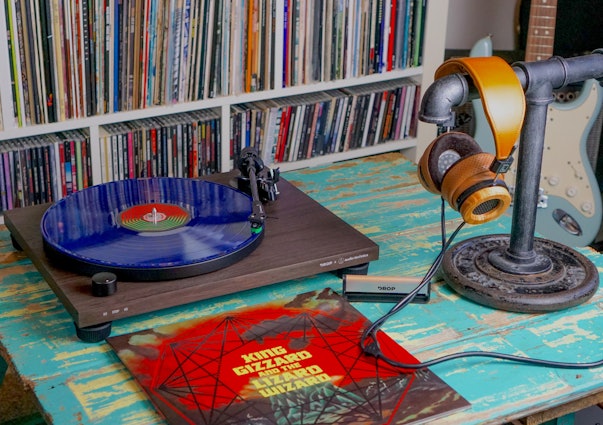
Development background: Analogue inception Creating a turntable from scratch is no mean feat, especially when it’s designed to be a complete entry-level turntable - the benchmark that Drop was aiming for. But, it had to be much more than that. See, the other thing about the vinyl community is that we are insufferable perfectionists, and so any turntable would need to heed exacting audiophile standards. So, anything that the Drop team undertook would need to be good enough to potentially be “the only turntable you’ll ever need”. So with this in mind, Drop turned to a manufacturer with decades of experience in the vinyl domain - Japan’s Audio Technica, which is a name that audiophiles will certainly love, respect, or at least recognise when it comes to headphones. Will explained that Drop has been keen to collaborate with Audio Technica for the best part of a decade and so when they were looking for a partner to collaborate with for their first turntable, they were a no-brainer. Audio Technica is particularly famous for their know-how with phono cartridges and their current flagship cartridge, the AT1000, can be all yours for the paltry sum of $6,999 if you're feeling spicy.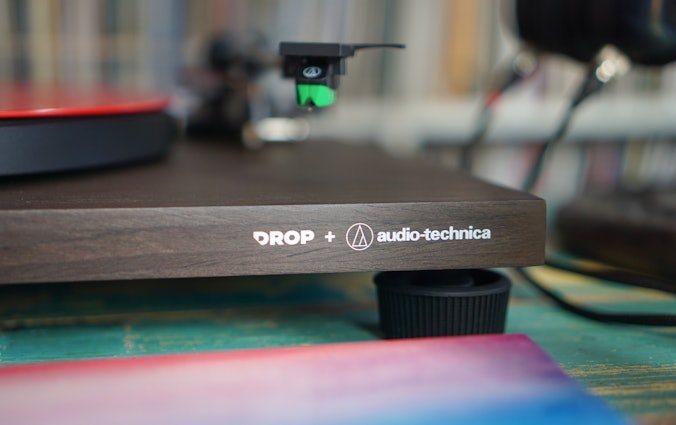
The Drop + Audio Technica Carbon VTA Turntable It’s a bit of a mouthful, but this is the moniker of the resulting turntable from Drop and Audio Technica’s first-ever collaboration, and Drop's first-ever turntable. Nominally based on the AT-LPW40WN, the Carbon VTA (the name we’ll go with from here) dips into the Audio Technica parts bin and boasts some premium features from more expensive models in the line-up exclusively for Drop customers. To describe the Carbon VTA in a tweet: It’s a fully manual belt-driven turntable with selectable 33/45 speeds, a replaceable AT-VMN95E cartridge and a built-in phono stage.
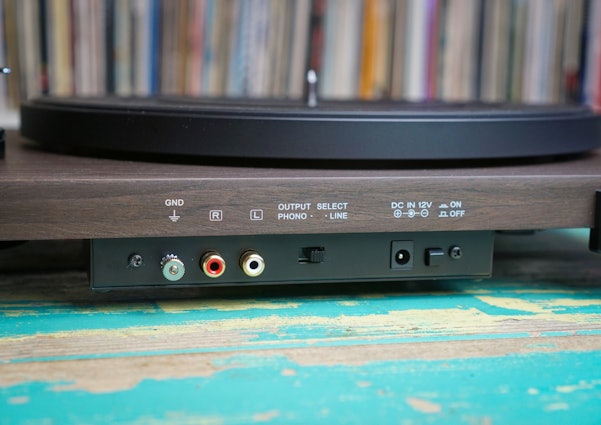
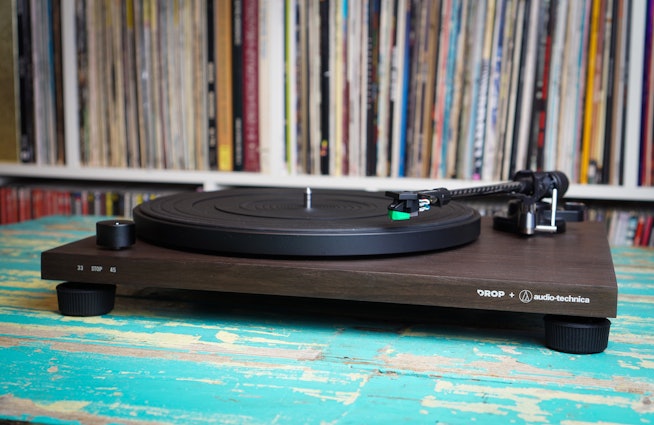
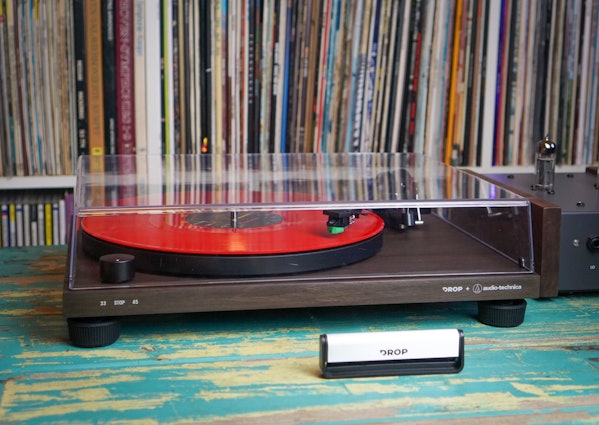
Admission: I’ve never set-up a turntable from scratch before. I had the good fortune to find my old Rega from an enthusiast second-hand dealer who installed a new-old-stock Shure cartridge and set-up the tonearm counter-weight for me. So I was a genuine guinea pig for with regards to getting the Carbon VTA up and running. A visual quickstart guide is supplied, which will be familiar to anyone who’s assembled IKEA furniture before: it’s pretty basic stuff.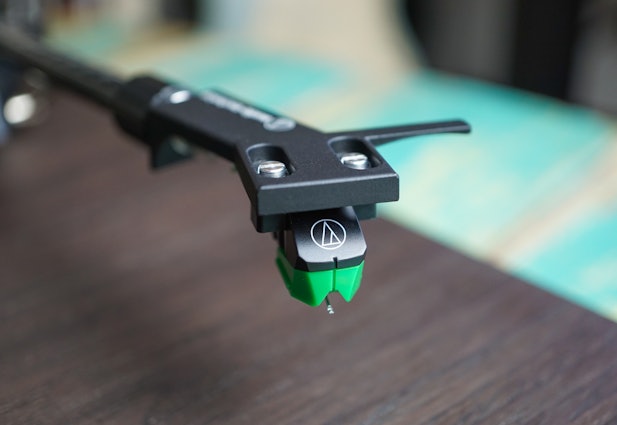

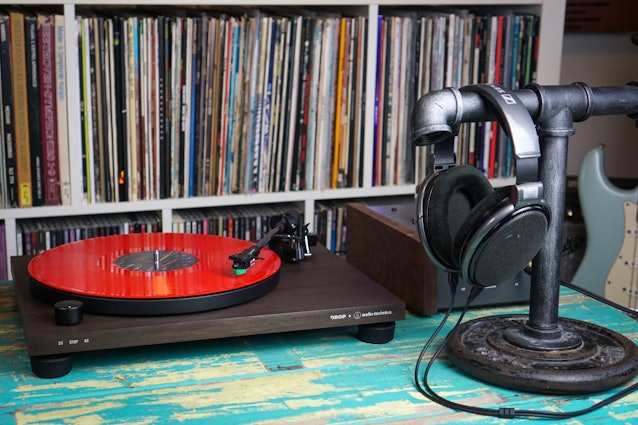
Playback All that was left to do was to plug the supplied RCA’s into my nearest headphone amplifier, select ‘line level’ out, plug in the 12V wall-wart, and I was ready to rock. I treated myself to Beck’s latest record ‘Hyperspace’ to test out the new Carbon VTA, and so I fired-up the Hagerman Tuba with my Sennheiser HD650’s, and away I went. The instructions supplied with the Carbon VTA worked a charm, because voila - it sounded bloody magical from the get-go.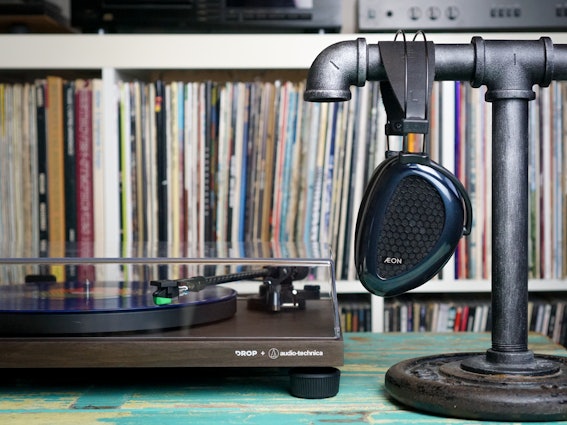

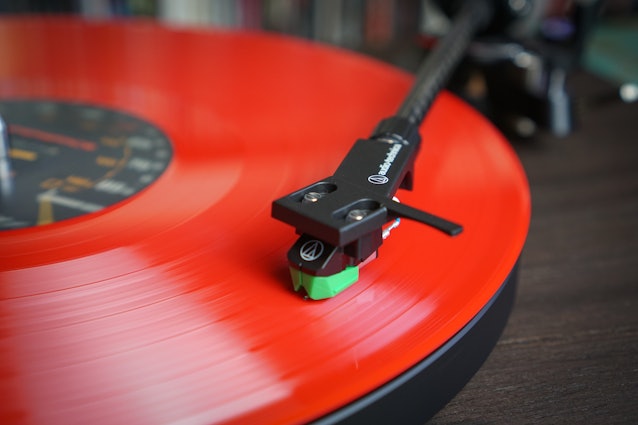

Development background: Analogue inception Creating a turntable from scratch is no mean feat, especially when it’s designed to be a complete entry-level turntable - the benchmark that Drop was aiming for. But, it had to be much more than that. See, the other thing about the vinyl community is that we are insufferable perfectionists, and so any turntable would need to heed exacting audiophile standards. So, anything that the Drop team undertook would need to be good enough to potentially be “the only turntable you’ll ever need”. So with this in mind, Drop turned to a manufacturer with decades of experience in the vinyl domain - Japan’s Audio Technica, which is a name that audiophiles will certainly love, respect, or at least recognise when it comes to headphones. Will explained that Drop has been keen to collaborate with Audio Technica for the best part of a decade and so when they were looking for a partner to collaborate with for their first turntable, they were a no-brainer. Audio Technica is particularly famous for their know-how with phono cartridges and their current flagship cartridge, the AT1000, can be all yours for the paltry sum of $6,999 if you're feeling spicy.

The Drop + Audio Technica Carbon VTA Turntable It’s a bit of a mouthful, but this is the moniker of the resulting turntable from Drop and Audio Technica’s first-ever collaboration, and Drop's first-ever turntable. Nominally based on the AT-LPW40WN, the Carbon VTA (the name we’ll go with from here) dips into the Audio Technica parts bin and boasts some premium features from more expensive models in the line-up exclusively for Drop customers. To describe the Carbon VTA in a tweet: It’s a fully manual belt-driven turntable with selectable 33/45 speeds, a replaceable AT-VMN95E cartridge and a built-in phono stage.



Admission: I’ve never set-up a turntable from scratch before. I had the good fortune to find my old Rega from an enthusiast second-hand dealer who installed a new-old-stock Shure cartridge and set-up the tonearm counter-weight for me. So I was a genuine guinea pig for with regards to getting the Carbon VTA up and running. A visual quickstart guide is supplied, which will be familiar to anyone who’s assembled IKEA furniture before: it’s pretty basic stuff.



Playback All that was left to do was to plug the supplied RCA’s into my nearest headphone amplifier, select ‘line level’ out, plug in the 12V wall-wart, and I was ready to rock. I treated myself to Beck’s latest record ‘Hyperspace’ to test out the new Carbon VTA, and so I fired-up the Hagerman Tuba with my Sennheiser HD650’s, and away I went. The instructions supplied with the Carbon VTA worked a charm, because voila - it sounded bloody magical from the get-go.



(Edited)

seiken1
1
May 12, 2020
MightygreyI enjoyed reading your review of this turntable and it’s cool you talked about your experience listening to records with headphones and which ones you used. I’ve started listening to vinyl with headphones more than speakers and I think it’s great. I use a Technics 1200 mk7 plugged into the phono input for a 1992 Sony receiver. My headphones are the Sony MDR-1A mk2. I thought about using a phono pre-amp/headphone amp combo and go exclusively with headphones, but have to think about the times I need to use speakers when my wife wants to listen or when friends come over. A second turntable with a built in pre-amp to a headphone amp would do the trick and I think I’ll explore that option down the line. Music, and all the different ways to enjoy it is the best.

oniongrass
7
Dec 20, 2020
MightygreyI'd add that the phono preamp does more than amplify the signal, it does RIAA equalization. To get music signals efficiently onto vinyl, low frequencies are reduced in amplitude and high frequencies are increased -- because otherwise the swings on the bass would be too wide for the space allocated to that groove. The playback device has to reverse that out by boosting bass and reducing treble. If you use line-level output, then you have to have your own phono preamp to do that RIAA equalization.

Xeressi
21
Jun 26, 2020
checkVerified Buyer
Great As A Gift
Got one of these for my father's 70th birthday to replace an old turntable that he bought back in the 1970s. We spent less than 20 minutes putting it together, then put on a few records only to discover how dusty and mismanaged his record collection was. Nevertheless, he could definitely tell the improvement in audio quality after a couple of minutes of listening to a familiar record. He's very happy with it. It also looks very nice in his media cabinet.
Recommends this product? Yes

Overview The Drop + Audio Technica Carbon VTA ( referred to as the Drop AT Carbon from here on out) is a strong entry in Drop's fairly impressive custom audio department, providing some unique and higher end features at an entry level price. Included in the box:
- Turntable (Aluminum Platter, Rubber Desk Mat, Dust Cover)
- AT-HS4 Headshell with AT-VM95E Cartridge
- 45 Adapter
- Record Brush
- RCA cable w/ Ground Cable
The Testing Now, before I go any further I'd also like to point out that this is an entry level turntable, but a good one at that. I mainly compared this to my Pro-Ject Debut Carbon Esprit as it has a closer resemblance of features and price than any of my other turntables (Clearaudio Concept, SOL, Technics SL-1200). The Rega RP-1 and U-Turn Audio Plus are also fairly good tables to compare to the Drop AT Carbon.





The Verdict Although the Drop AT Carbon isn't the cheapest option out there, I'm glad they didn't set out to make the most budget turntable possible in this collaboration. Instead of trying to shave off every penny they could (as they do in some collaborations), they seemed to manage price and features in a way that resulted in a rather unique offering in this price range. So while there may be some people looking for a more purist entry into the world of turntables (of which there some dominating options already available in that dept.), there are those that will value the convenience and flexibility the Drop AT Carbon offers along with quality that should get a lot of great use out of this turntable. As someone with a masters in audio engineering and hundreds of hours logged in full analog studios, plenty of time spent cutting masters on a lathe, a former record store owner, and avid record/turntable collector, I approve of this deck. I asked for this back in 2016 even haha....

(Edited)

NTTD
75
Mar 30, 2020
Do you mean the Fluance RT85?
I think the better question is this Drop vs the Fluance RT83 which match in price.
Though for $150 more for the RT85 you get a heavy acrylic platter and an Ortofon Blue cartridge. It would cost you about $200 just to upgrade to that stylus.
I think one could argue that the RT85 is a "better" deal, but the difference between $350 and $500 is not insignificant.
Another question is could anyone in the "entry level quality turntable" market tell the difference between the above options. I believe that is the market these TTs are shooting for.
I'm leaning towards the RT82 as it's $50 cheaper still but is from the same family as the RT83-85 and can be upgraded should I ever feel the need.
At this stage I honestly doubt I'd be able to tell the difference between an Ortophon OM 10 and 2M Blue.

NTTD
75
Mar 30, 2020
Do you mean the Fluance RT85?
I think the better question is this Drop vs the Fluance RT83 which match in price.
Though for $150 more for the RT85 you get a heavy acrylic platter and an Ortofon Blue cartridge. It would cost you about $200 just to upgrade to that stylus.
I think one could argue that the RT85 is a "better" deal, but the difference between $350 and $500 is not insignificant.
Another question is could anyone in the "entry level quality turntable" market tell the difference between the above options. I believe that is the market these TTs are shooting for.
I'm leaning towards the RT82 as it's $50 cheaper still but is from the same family as the RT83-85 and can be upgraded should I ever feel the need.
At this stage I honestly doubt I'd be able to tell the difference between an Ortophon OM 10 and 2M Blue.

Fayne
2586
Mar 10, 2020
checkVerified Buyer


(Edited)
Recommends this product? Yes

Fayne
2586
Jan 25, 2021
Yeah, I've read reviews about it and definitely have been tempted in the past. My hang-up is mostly the chassis modifications, not the potential soldering work. I hates drilling into stuff, so final.
Honestly, if I were to do it, I'd likely be buying a bare board and putting it together myself (or taking the schematic from the pdfs Les keeps updating, and laying it out myself with Eagle and having the boards fabbed). That'd help justify the pile of cash I spent on my oscope, mmeter, bench psu, isolated variac, and signal generator. Not to mention I've got the vast majority of the components needed on hand due to OCD purchasing from Mouser for other projects (why buy 10 at $0.50-0.70 a piece when I can buy 200 at $0.05). ^^;
tim273
11
Jan 25, 2021
FayneMakes sense, the other option is building a kit from Bottlehead, they have two phono preamps the Reduction (https://bottlehead.com/product/reduction-1-1-phono-preamplifier-kit/) and Eros (https://bottlehead.com/product/eros-2-phono-preamplifier-kit/). It all depends on what you want to spend. If you get the Reduction, get the Integration upgrade as well.
I was going to go with the Reduction initially but I didn't want to spend $600+ (with all the upgrades) so I went with the modded Yaqin, which ended up being close to that price all said and done, but not quite.
I built a Crack+Speedball and it's awesome! I'm using that with my setup Record Player (soon to be the one above when it ships) -> Modded Yaqin -> Modded Bottlehead Crack+Speedball.
(Edited)

Multiplex
24
Mar 4, 2020
My super long-winded DROP+Audio Technica Carbon VTA review...

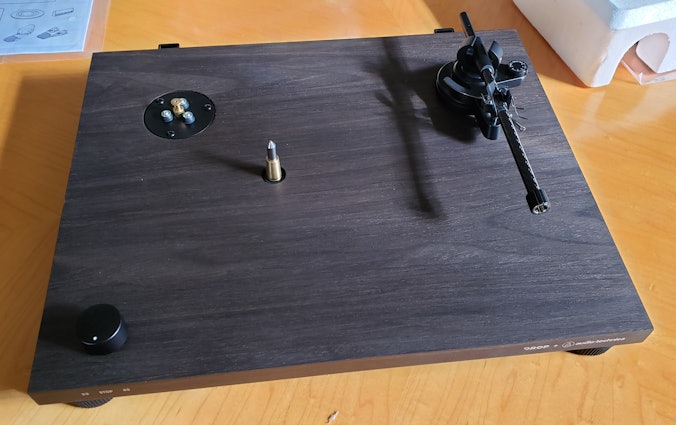
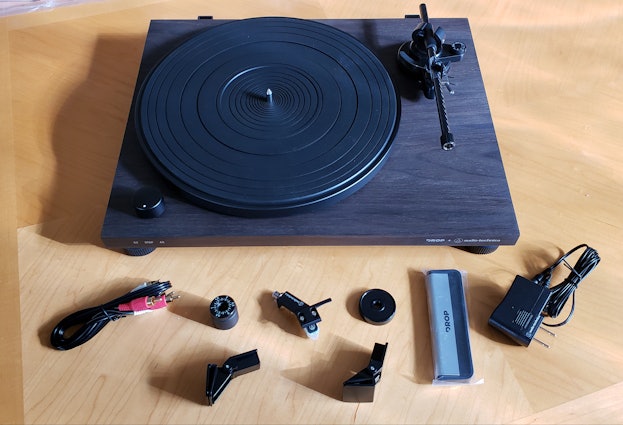
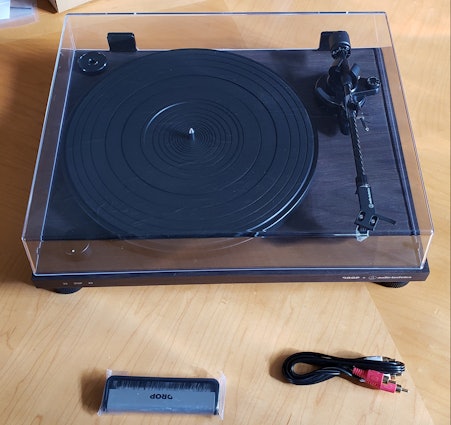
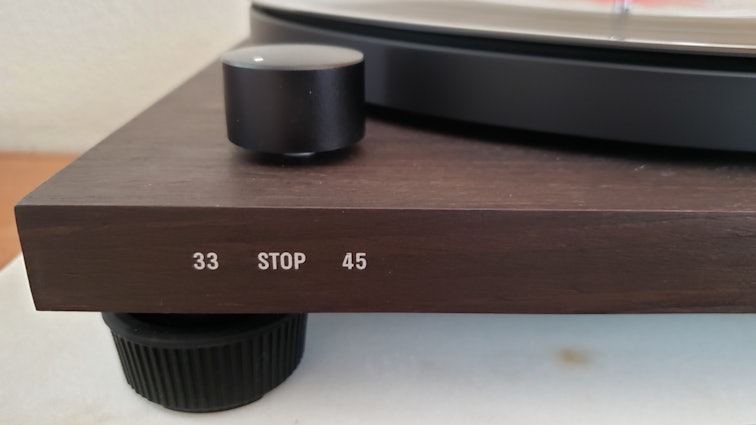
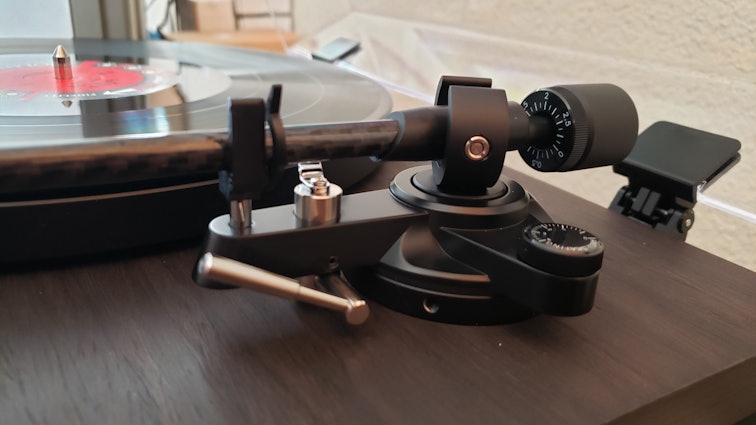
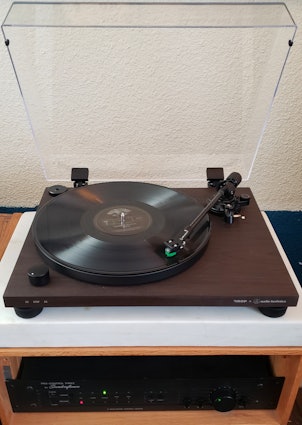
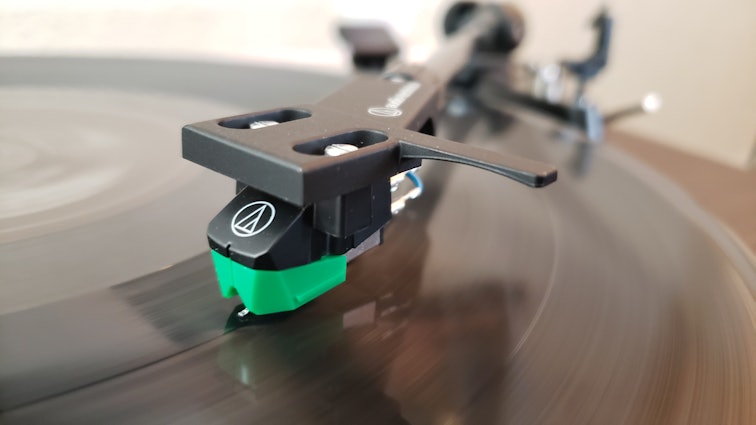
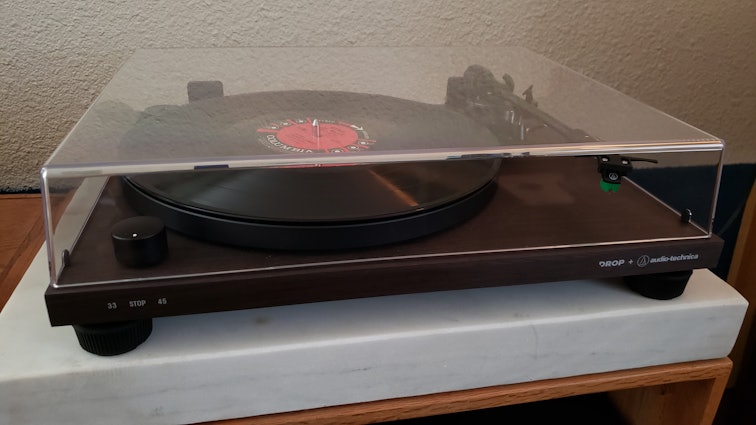











(Edited)

Nottagorilla
65
Jun 9, 2020
Well!
There's a fair amount to unpack in your attempt to clarify the cartridge compliance (cantilever suspension "floppiness") vs. Tonearm "effective" mass (not to be confused with real/total arm mass which is a non-issue for this discussion).
Then there is the business of damping; which is either designed-in to the cartridge's cantilever suspension, or is added externally to some of the fancier tonearms you see in the form of a trough or "vat" of gooey, messy, & unwantedly-mobile silicone oil (it has properties that give it an ability to just "creep" away from where you put it, & make a f***ing mess all around the tonearm. Usually seen seeping out of damped cueing lift mechanisms on a crummy recent Thorens TURDtable like TD203 & 309...).
As you may gather, my opinion of external damping to compensate for cartridges that are poorly designed to begin with is very low.
Working for a Grado dealer, I have experience with the Black & Green models & have several vintage F & G series models in my junk collection of 100-odd cartridges...
Other than ongoing issues of shabby American quality that has always dogged Grado (to their credit, QC is MUCH better than it ever was. Problem is, so is everyone else's!), their current products at the low-end of their line are VASTLY better than CRAP like the late, rave-reviewed by idiots who would never stoop to using it themselves as a "daily driver" (like the rave reviews for the AWFUL-sounding Rega RB250 & 300 tonearms!).
The 1970's predecessor to the Grado Black you own is the FTE+1: plainly a piece of ship, if you get my drift.
I owned it, bought it based on the raves of a Hind-End Fraudio Crapazine that you're sophisticated enough to be familiar with: "The Absolute Sound" (Absolute Clown is closer to it, IMHO).
The great audio God Joe Grado didn't believe in anti-skating compensation/adjustment, just as another slop-dick New York turntable maker Harry Weisfeld (VPI) also is too lazy/deaf/stupid to bother with.
On top of telling the customer not to bother with anti-skating compensation for the FTE+1, he also LIED about the recommended tracing force for this POS: 1.5g
Application of that recommendation resulted in gross mistracking & instant groove destruction of even modestly-loud groove modulations.
Farting around, the very lowest VTF that gave barely-acceptable results was 2.25g.
2.5g was best, but what little detail this CRAYON stylus had was further diminished by more dulling of its rather-limited treble extension...
Your "Black" cartridge sounds like it a actually might have a true elliptical stylus, unlike the "twin tip" paralleled-conical shape those old F & G series carts had.
The cantilever is noticeably thinner & better made; no longer dingy & dull-looking, often with little dents visible along the length!
Still, the Black & Green models I've worked with have noticeably sloppy (off-center) positioning of the stylus shank on the flattened portion at the end of cantilever. Doesn't seem to affect the sound, but the Chinese-made VM95E for half the price has NO such obvious tooling-related problems.
The basic design of your cartridge is now 55 years-old, & probably made from much of that horribly tiref
rhpot1991
228
Mar 9, 2020
Copying over my review from Reddit.
Many of us know Drop for their headphone collaborations, they won me over by finally making JVC IEMs available outside of Japan. Their latest product is a collaboration with Audio Technica for their first turntable. I was sent an advanced unit to review, here are my thoughts and impressions.
Drop hasn’t mentioned a model on their site, but the box identifies it as AT-LP-DCVTA-EB.
My stack prior to receiving this unit was
Pro-Ject Debut Carbon Espirit SB > Pro-Ject Tube Box S > Onkyo TX-NR838 > ELAC Uni-fi UB5 and HSU VTF-1 MK3
I added a Pro-Ject Clamp It and upgraded the stylus to an Ortofon Blue along the way. For the purposes of my testing I swapped out turntables and kept everything else the same. In the process I ignored any included accessories as the ones I had installed seemed to be better quality, but I’ll include some thoughts on them along the way.
Overall this turntable seems very similar to the AT-LPW40WN with a bunch of upgrades added.
The Great
- Easily upgradeable cartridge/stylus - The turntable comes with an AT-VM95E mounted on an AT-HS4 headshell. Any stylus in the AT-VM95 line can be added on in a matter of seconds, and this can be even easier if you get a new headshell. Ultimately I couldn’t resist adding a Shibata instead, which can be done for $179. Note that most pre-mounted cartridges use the straight headshell where this needs the curved one.
- Upgraded tonearm - Drop normally picks something to improve in their collaborations. This time they concentrated heavily on the tonearm, replacing the plastic base with metal while adding Vertical Tracking Alignment. To the best of my knowledge VTA is not typically available in entry level audiophile turntables. The tonearm lift was also upgraded to solid metal.
- True anti skate - This is a step up over the weighted mechanism that other turntables utilize.
- Built in phono - This appears in my great list not because the unit has it, but because Drop took the community bypass mods and built a true bypass right into the unit. Available for those who need it, while not introducing issues for those who do not.
- Comes with everything you need - In the box are a set of interconnects, a 45 spacer, and a carbon fiber brush. As mentioned above I didn’t need or use any of these, but nice to have. The interconnects don’t seem as high quality as the ones that came with my Pro-Ject.
- Built quality - Steady here. The knob is better than the button on my Pro-ject, and the motor seems to hit speed much quicker without a warm up needed. The MFD base could be easily confused with a solid chunk of wood.
- The included Green (AT-VM95E) stylus - Sure it is competent, but many other audiophile turntables ship with an Ortofon 2M Red. Granted the Ortofon line isn’t as easy to upgrade without replacing the cartridge. I didn't bother switching back to the Ortofon Red for comparison, but the styluses land as expected Audio Technica Green < Ortofon Red < Ortofon Blue < Audio Technica Shibata.
- Non upgradeable platter - This is my only real complaint. My Pro-Ject has a nice acrylic platter, which unfortunately won’t work with this Audio Technica turntable. The VTA support means you can utilize a variety of different mats, mitigating any issues here. Let me be clear the platter itself is a nice solid metal with no wobble whatsoever, and it comes with a nice rubber mat; it is just disappointing that you can upgrade on other brands and not here. Everyone can let me know if I should try a leather or acrylic mat next.
- No 78 support - Might not matter for most people.

metafrolic
17
Mar 3, 2020
This is hands down a fantastic turntable with a multitude of thoughtful details. The price point is really great, and its performance went far beyond what I expected. Also it's well detailed and just plain looks good!
I was a bit skeptical - having loved my Pro-Ject Debut Carbon over the years. Aesthetically, I think they are both pretty nice - but there are some subtle details that make this more enjoyable to use. One, the ability to shift between 33 and 45 rpm without lifting up the entire platter and manually changing the belt has gotten me to actually play my 45's again (call me lazy!). The built in phono preamp actually sounds better than my external pro-ject preamp too - I was surprised. I should mention I'm playing through a Peachtree Nova 150 amp. I was able to hook both up at the same time and do a side-by-side test using the auxiliary input as well. It just had more clarity and punch at higher volumes than my Pro-ject. The setup was also a bit more straight forward and the leveling feet and anti-skate were easy to adjust.
I noticed a lot of reviews pointed out the lack of an auto-stop function. I don't get this. I've only had this function in my first turntable - the AT-LP60 - which I loved, but it always felt cheap. This is a far more sophisticated machine in look and feel. That function can be easily added later if wanted - but I like it how it is, personally.
Overall - I recommend this turntable for the price-point and feel it raised the bar of design for Audio-Technica in general (understanding they make some solid turntables at all price points).

TB-1
36
Apr 12, 2020
checkVerified Buyer
Beautiful table!
Packaged very well. Easy setup. Looks great. Spent a day breaking it in listening casually using the built in phono pre. It didn’t offend, fairly warm but lacking high and low extension, somewhat diffuse imaging and not much soundstage. Day 2 used Schiit mani. Mostly I mprovement across the board. Still thin sounding and small soundstage. Day 3 hooked up old (at least 10 years) Project Tube Box phono pre for fun. Total synergy! Huge soundstage width, depth, height, image clarity, deep bass, clear sweet airy highs. This table scales up well.
Recommends this product? Yes

amiga505
16
Jun 24, 2020
It's a stab in the dark, but 10-15 years ago they may have made the 'real thing'. Current versions are hybrids, not proper tube pre-amps.
Mojani
14
Nov 6, 2023
checkVerified Buyer
I set this up while on the phone with ATT customer service - 15 min

Recommends this product? Yes

T.Fernandez
799
Collabs
Jan 4, 2024
MojaniUpgrading the stylus/cartridge is often the best way to upgrade the sound of your TT.
Id recommend you look at the AT-VMN95SH stylus which is a direct replacement for the cartridge that ships with the turntable. It will drop into place on the existing cartridge body without the need to disconnect the wires or realign the cart on the headshell.
Either the Shibata or MicroLinear stylus would be a solid step up.
Showing 61 of 237
Recent Activity
